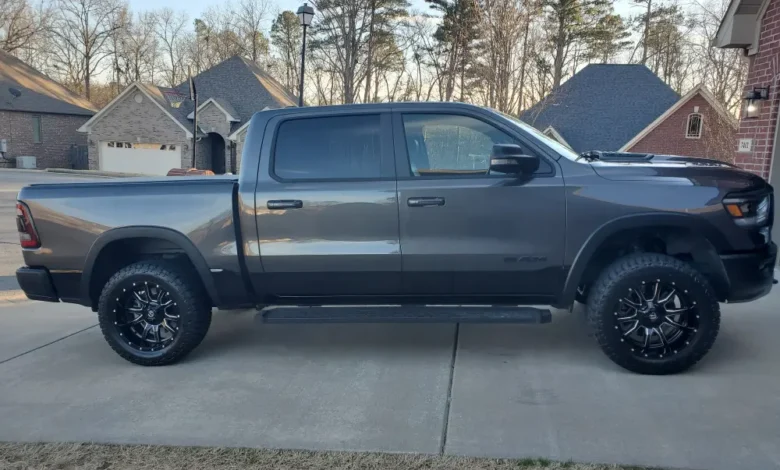Ram 1500 35/11.50r17 With -12 Offset

Ram 1500 35/11.50r17 With -12 Offset: Upgrading a Ram 1500 to 35/11.50R17 tires mounted on wheels with a –12 mm offset is a popular choice among offroad and lifted truck enthusiasts. It can dramatically change the look, stance, and performance of your truck. But it also comes with challenges. Below, we’ll dissect fitment, benefits, drawbacks, necessary modifications, and how it affects handling and reliability.
What Does 35/11.50R17 Mean & What Does –12 Offset Imply?
Before judging fitment, let’s break down what these technical terms mean:
-
35/11.50R17
-
“35” refers to the overall tire diameter in inches (≈ 35.0″).
-
“11.50” is the width (in inches) of the tread section.
-
“R17” means it’s a radial tire intended for a 17-inch wheel.
-
For example, the Toyo Open Country A/T III 35×11.50R17 has a diameter of ~34.5″ and a width of 11.4″ on a 17″ wheel.
-
-
Offset (–12 mm)
-
Offset is the distance from the wheel’s mounting surface to its centerline.
-
A negative offset (-12 mm) pushes the wheel outward relative to the hub. The more negative, the more “poke” (wheels stick out).
-
With –12 mm, the wheels will sit farther away from the body, widening the track.
-
So pairing a wide, large tire with a negative offset means more aggressive stance, but also more stress on suspension, fender clearance, and steering linkage.
Fitment Considerations: Will 35×11.50R17 on –12 Offset Fit on a Ram 1500?
You might find various forum threads or build galleries where people have successfully run 35s on their Ram 1500s. For example:
-
A user noted a 2015 Ram 1500 running 17×9 wheels with 35/11.50R17 tires after a leveling kit, and they confirmed it fit.
-
Others say 35″ tires can fit a Ram 1500 stock, but on tight turns or full lock you may see rubbing without size changes or trimming.
-
Some ask generally “what’s the biggest tire I can fit?” and get answers that 35s are doable with modifications.
Here’s what you need to check carefully:
-
Wheel Width & Backspacing
A 35/11.50R17 tire fits best on wheels between roughly 7.5″ to 10″ wide. Combined with –12 offset, check how far it extends outward. If the backspacing is small, the inside edge might interfere with suspension, steering arms, or control arms. -
Fender / Wheelwell Clearance
On full lock, vertical articulation, or when the suspension cycles, the tire must avoid rubbing the fender flare, inner liner, or pinch welds. Negative offset increases risk. -
LH & RH Clearance (Suspension & Steering)
Contact points inside (tie rods, ball joints, sway bar links) must be considered. The more the wheel pokes out, the more leverage stress on these parts. -
Suspension / Lift / Leveling
Many builders run a level kit (2” front leveling or a small lift) so that the front wheel has more clearance.
Without this, the stock rake can cause more rubation. -
Turning Radius & Ackermann Geometry
The wheel and tire may hit the rear of the front fender or rub in reverse on steep driveways unless properly oriented and trimmed. -
Track Width & Stability
With negative offset, your wheels push outward, increasing track width. That may help cornering but also increases stress on wheel bearings and CV joints.
In summary: yes, 35/11.50R17 on –12 offset can be made to fit on a Ram 1500, but not without careful selection, modifications, and testing.
Pros & Cons of Running 35/11.50R17 with Negative Offset
When you commit to this aggressive setup, there are advantages and drawbacks to understand.
Pros
-
Aggressive Stance & Appearance: The outward poke, wide footprint, and large tire look impressively rugged.
-
Better Traction in Off-Road Conditions: The wide 11.50″ width gives more ground contact, useful in dirt, mud, or loose surfaces.
-
Increased Ground Clearance: The 35″ diameter raises vehicle height a bit (if gear ratios allow) so the underbody is safer over obstacles.
-
Wider Track Stability: The negative offset pushes wheels outward, increasing lateral stability in some conditions (but with caveats).
Cons / Tradeoffs
-
Increased Scrubbing & Binding: When you steer, the tire’s extra width may scrub more on full lock.
-
Higher Stress on Steering & Suspension: The leverage increases forces on tie rods, wheel bearings, ball joints, etc.
-
Fuel Economy Loss: Larger, wider tires are heavier, add rolling resistance, and lower aerodynamics — expect mpg drop.
-
Speedometer / ECU Calibration: Without recalibration, the speedometer & gear ratios may be off due to larger tire size.
-
Potential Legal / Inspection Issues: In some jurisdictions, wheels sticking beyond fenders or failing clearance rules may violate vehicle inspection laws.
-
Rubbing or Damage Risk: Especially under articulation, tight turns, or load, you might get rubbing or damage.
What Modifications Are Typically Required to Make It Work Reliably
To run this setup well, a few modifications are often necessary to prevent problems and preserve longevity.
-
Leveling / Lift Kit
Installing a front leveler kit or small lift ensures more room between tire and control arms / fender. Many users run a 2″ level before jumping to 35s -
Fender Trimming / Rolling
The inner lip of fenders may need trimming or rolling (heat + bending) to allow tire flex under load without hitting. Use a fender roller. -
Wheel Spacers (if necessary)
In some cases, thin spacers (5–10 mm) may help shift wheel outward or inward to optimize fit. But they increase stress and have to be high quality load-capable spacers. -
Better Steering Components / Strength Upgrades
Since leverage is increased, upgrading tie rods, ball joints, and even steering stabilizers may be wise. -
Regearing Differential (Optional)
35″ tires change effective gear ratios. In some cases, to preserve performance and torque, people regear (e.g. to 4.10 or 4.56 depending on usage). -
Alignment & Camber Adjustments
You may need more negative camber or toe adjustments to keep the large tire tracking properly. -
Speedometer / ECU Tuning
Use a tuning tool or module to correct speedometer and transmission shift points to account for the larger tire height.
By combining these mods, you reduce the risk while making the setup usable for daily driving or off-road use.
Best Tire & Wheel Options for 35/11.50R17 on –12 Offset
Choosing the right tire and wheel combo is critical. Some tires known in that size:
-
Nitto Ridge Grappler A/T 35×11.50R17 — a hybrid all-terrain that balances road manners and off-road capability.
-
Toyo Open Country A/T III 35×11.50R17 — dimensions: diameter ~34.5″, width ~11.4″
-
Open Country R/T Pro 35×11.50R17E — built for mixed terrain, heavy load rating.
For wheels, a 17″ wheel with a width between 8″ to 10″ and a –12 mm offset is a strong match. Many custom offsets galleries show 17×9 wheels with –12 mm offset on Rams fitted with 35″ tires.
Make sure the wheel’s backspacing is compatible so it doesn’t push the tire too far in or out.
Real Owner Experiences & Common Questions
Here’s what actual Ram owners report in forums:
-
Some say they run 35/11.5 on their Ram 1500 without rubbing, especially in the rear, though full lock or suspension travel sometimes causes minor interference.
-
Others warn that trim or fender mods may be necessary on the front when turning fully.
-
Many mention that trucks with a leveled front or mild lift accommodate 35s more cleanly.
-
Some note that spacers or negative offset wheels often appear in pictures of trucks with aggressive stances showing the wheels poking outward.
A tip: always test full turning, suspension compression, and full articulation before declaring a setup perfect.
Conclusion
Running 35/11.50R17 tires with –12 mm offset on a Ram 1500 is absolutely doable and can yield a striking, capable build, but it demands careful planning. To summarize:
-
Understand all specs (tire diameter, width, wheel offset)
-
Pick wheels in the right width range for proper mounting
-
Ensure plenty of fender clearance via lift kits or trimming
-
Reinforce suspension, steering, and alignment to handle the extra stress
-
Choose quality tires that match usage (all-terrain, hybrid, etc.)
-
Test thoroughly and adjust as needed
If you’d like, I can model how the truck’s performance (speedometer error, ground clearance, gearing impact) changes with that setup, or simulate clearance with CAD.




